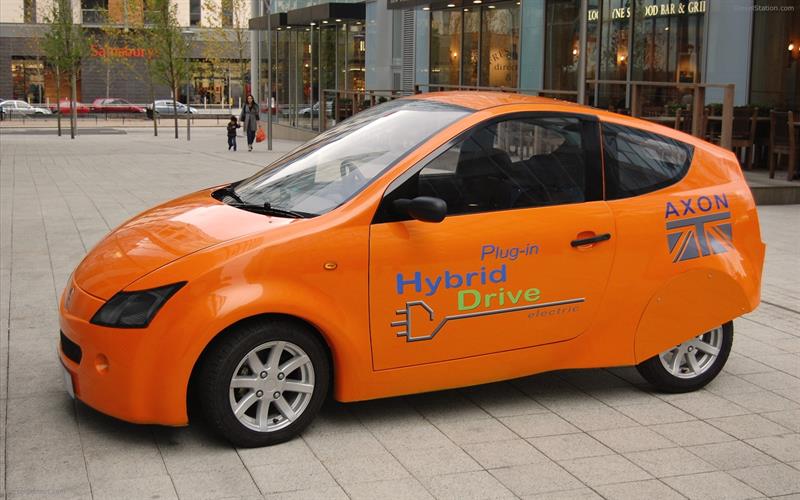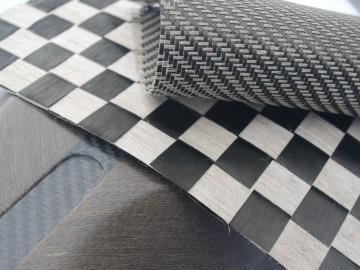The niche sports car company, Westfield, is about to start tests with a carbon fibre frame made of Axontex in one of its Sport 250 cars. The frame can replace the standard steel frame the car is supplied with. One of the big selling points of Axontex is that it can be made for the same price as an aluminium frame.
“Westfield said ‘prove it’,” said Sanders, who is also director of Axon Automotive. “So we designed a passenger cell for them which they had priced in aluminium and we met that price with Axontex.
“Our frame is around 35% lighter than the aluminium frame and 70% lighter than the standard steel frame,” he added.
Sanders and his team were confident in their ability to produce this frame for Westfield because their technology has already proved itself. In 2011 the company built the Axon 8080, a 500kg, two-seater plug-in hybrid electric vehicle that used a small petrol powered engine for use in towns and cities. It emitted less than 50g/km of CO2 in a government emissions test, half the level needed for free annual road tax in the UK.
“We couldn’t convince anyone to buy them,” admitted Sanders. “Nonetheless, it’s a demonstrator, we proved the technology worked.”
 The Axon 8080 plug-in hybrid electric vehicle
The Axon 8080 plug-in hybrid electric vehicle
In 2012 Axon went on to produce the Axon 60, which won the company a JEC Award for Innovation. Using Solid Edge, an FEA model was made to demonstrate the performance of the Axontex frame in a crash and to analyse its torsional rigidity. The Axon team put the frame through a full crash test for a 600kg vehicle and through adjusting various material grades and thicknesses and running iterative models, a compliant structure was specified. This allowed them to produce three road-going models, a petrol electric hybrid, a pure electric vehicle and an internal combustion engine that ran on hydrogen.
Hyundai approached Axon to provide an Axontex frame for its hydrogen fuel-cell powered Intrado concept car for the 2014 Geneva Motor Show. Hyundai reported that the Axontex frame achieved a reduction in weight of 70% over a traditional steel frame. It also said that the strength and rigidity of the central structure would allow body panels to be made from any material, giving designers greater flexibility and aiding reparability.
This led to Axon to offer Westfield a frame which featured the same benefits as it had on the Axon 60 and Hyundai Intrado: a ‘crash proof’ carbon fibre frame that costs the same as a lightweight aluminium one. It is also lighter and stiffer allowing for higher cornering speeds and stability.
The next step is for a professional racing driver to test the Westfield with the Axontex frame on a race track. “It’s 154% stiffer and it’s quite a bit lighter, so we’re kind of expecting the racing driver to come back and say he likes it,” said Sanders. “Let’s assume he does, then it will go through crash tests - which we know it will pass - and it can then go into production.”
What makes Axontex so innovative and inexpensive is the way it is made. Instead of being constructed like a conventional carbon fibre beam, which are hollow and filled with foam, Axontex incorporates a carbon cross-web which effectively makes it more like an I-beam. Sanders explained that if it is loaded from the side it won’t buckle. It is designed to crush progressively in a crash scenario so it can absorb large amounts of energy without failing.
Sanders continued: “To get a column strong enough when it’s hollow you have to make it very deep, which uses a lot of carbon. If you think about the size of the door sill of a BMW i8, for example, there’s a lot of carbon to step over to get into the car because they’re trying to make a hollow beam buckle-proof by making it bigger. We make ours buckle-proof by making it cleverer and by using less carbon.”
The production process for Axontex doesn’t involve any expensive aerospace or Formula 1 technologies. Axon uses a low cost manufacturing group that removes a lot of the capital from the process and strips down the tooling prices. The process is also said to produce a carbon yield of 97%, whereas larger car manufacturers only reach yields of between 50 to 65%.
As long as the test of the carbon fibre frame by Westfield is a success, Axon expects it to be available for Westfield’s customers between the end of 2016 and the start of 2017.
As for the next steps for Axon and Far Composites, they are looking to take the material to OEM customers for mass adoption. However, OEMs are looking for short cycle times and high process repeatability as well as low costs.
Sanders is confident about it passing crash tests and being able to achieve mass production part costs as Axontex costs the same as aluminium parts. He also thinks the company is ready to meet investment costs because of its range of low cost tooling solutions. But there are other factors like supply chain and short cycle times that he is less confident about; even though the Axontex resin cures in around 60 to 90 seconds, they would need a cell to prove it.
“Process repeatability is an entirely tougher standard - we’re talking about one or two PPMs of rejects, and very tight repeatability. We physically haven’t made enough cars to do the maths to prove that we can actually hit those target standards, because you have to have samples of 100 and we haven’t made 100 cars yet,” he admitted.
The Westfield test, as well as some others the companies are working on should help with getting them closer to working with OEMs. However, Sanders could not elaborate on these, he concluded: “A lot of what we do is covered by NDAs so there’s a lot of stuff I can’t tell you about, come back next year and maybe I’ll have some more news for you.”
As part of the Innovate UK funded CARBIO project, Composites Evolution has developed a carbon/flax automotive roof panel using its Biotex Flax material. Compared to carbon, flax fibres are renewable, lower in cost, CO2 neutral and have excellent vibration damping properties. The 50/50 carbon/flax hybrid biocomposite panel features equal bending stiffness to carbon fibre, but is 15% cheaper, 7% lighter and exhibits 58% high vibration dampening. Composites Evolution has also developed hybrid fabrics that contain carbon and flax yarns that allow tunable performance, vibration dampening and unique aesthetics at lower cost than carbon. This material would suit complex structural and decorative parts on sports as well as automotive industries. |








 Carbon flax hybrid offers greater damping
Carbon flax hybrid offers greater damping


